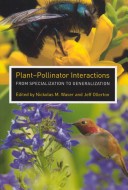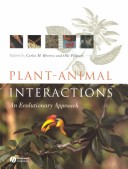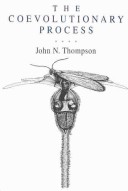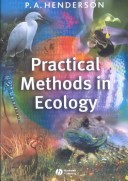Books
A selection of books about pollination, plant-animal interactions and ecology. Some of these books can be partly read at google books (see links). In progress!
Plant - pollinator interactions: from specialization to generalization
Waser, N.M. and J. Ollerton (eds). 2006. Plant - pollinator interactions: from specialization to generalization. The University of Chicago Press, Chicago and London.
"Just as flowering plants depend on their pollinators, many birds,
insects, and bats rely on plants for energy and nutrients. This
plant-pollinator relationship is essential to the survival of natural
and agricultural ecosystems. Plant-Pollinator Interactions portrays the
intimate relationships of pollin ation
over time and space and reveals patterns of interactions from individual
to community levels, showing how these patterns change at different spatial
and temporal scales. Nickolas M. Waser and Jeff Ollerton bring together experts
from around the world to offer a comprehensive analysis of pollination, including
the history of thinking about specialization and generalization and a
comparison of pollination to other mutualisms. An overview of current
thinking and of future research priorities, Plant-Pollinator
Interactions covers an important theme in evolutionary ecology with
far-reaching applications in conservation and agriculture. This book
will find an eager audience in specialists studying pollination and
other mutualisms, as well as with biologists who are interested in
ecological, evolutionary, and behavioral aspects of the specialization
and generalization of species."
ation
over time and space and reveals patterns of interactions from individual
to community levels, showing how these patterns change at different spatial
and temporal scales. Nickolas M. Waser and Jeff Ollerton bring together experts
from around the world to offer a comprehensive analysis of pollination, including
the history of thinking about specialization and generalization and a
comparison of pollination to other mutualisms. An overview of current
thinking and of future research priorities, Plant-Pollinator
Interactions covers an important theme in evolutionary ecology with
far-reaching applications in conservation and agriculture. This book
will find an eager audience in specialists studying pollination and
other mutualisms, as well as with biologists who are interested in
ecological, evolutionary, and behavioral aspects of the specialization
and generalization of species."
Plant-Animal Interactions: An Evolutionary Approach
Plant-Animal Interactions: An Evolutionary Approach (2002). Edited by Carlos M Herrera and Olle Pellmyr. Oxford and Malden (Massachusetts): Blackwell Science.xii + 313 p + 4 pl; ill.; index. ISBN: 0–632–05267–8.
"Interactions between plants and animals are incredibly diverse an d complex
and span terrestrial, atmospheric and aquatic environments. The last decade
has seen the emergence of a vast quantity of data on the subject and there
is now a perceived need among both teachers and undergraduate students for
a new textbook that incorporates the numerous recent advances made in the
field. The book is intended for use by advanced level undergraduate and beginning
graduate students, taking related courses in wider ecology degree programmes.
Very few books cover this subject and those that do are out of date."
d complex
and span terrestrial, atmospheric and aquatic environments. The last decade
has seen the emergence of a vast quantity of data on the subject and there
is now a perceived need among both teachers and undergraduate students for
a new textbook that incorporates the numerous recent advances made in the
field. The book is intended for use by advanced level undergraduate and beginning
graduate students, taking related courses in wider ecology degree programmes.
Very few books cover this subject and those that do are out of date."
The Coevolutionary Process
The Coevolutionary Process. By John Thompson. University of Chicago Press. Chicago, 1994.
"Traditional ecological approaches to species evolution have frequently
studied too few species, relatively small areas, and relatively short time
spans. In The Coevolutionary Process, John N. Thompson advances a new conceptual
approach to the evolution of species interactions—the geographic mosaic
theory of coevolution. Thompson demonstrates how an integrated study of life
histories, genetics, and the geographic structure of populations yields a
broader understanding of coevolution, or the development of reciprocal adaptations
and specializations in interdependent species.Using examples of species interactions
from an enormous range of taxa, Thompson examines how and when extreme specialization
evolves in interdependent species and how geographic differences in specialization,
adaptation, and the outcomes of interactions shape coevolution. Through the
geographic mosaic theory, Thompson bridges the gap between the study of specialization
and coevolution in local communities and the study of broader patterns seen
in comparisons of the phylogenies of interacting species."
mosaic
theory of coevolution. Thompson demonstrates how an integrated study of life
histories, genetics, and the geographic structure of populations yields a
broader understanding of coevolution, or the development of reciprocal adaptations
and specializations in interdependent species.Using examples of species interactions
from an enormous range of taxa, Thompson examines how and when extreme specialization
evolves in interdependent species and how geographic differences in specialization,
adaptation, and the outcomes of interactions shape coevolution. Through the
geographic mosaic theory, Thompson bridges the gap between the study of specialization
and coevolution in local communities and the study of broader patterns seen
in comparisons of the phylogenies of interacting species."
Practical Methods in Ecology
Practical Methods in Ecology. P.A. Henderson. Blackwell Science, Oxford, UK,. 2003, 163 + vii pages. Price AUD$66. ISBN. 140510244
"There are few books available that provide a good introduction to the methods
and techniques for ecological research. This book will be invaluable to lecturers
teaching field courses and students undertaking project work in ecology.Each
chapter will focus on an ecological technique. It will have an introductory
section that describes the ecological principles and theory. This will then
be followed by example applications. These will focus on three most  common
habitats where teachers take students for fieldwork; the seashore, ponds
and lakes, fields and woodland. Gives specific worked examples from the main
ecosystems used for undergraduate study - seashore, lakes/ponds, field and
woodland. Only introductory text specifically focused on field techniques.
Great 'how-to' guide that will show student exactly how to carry out each
method. Only text to emphasise the principles behind the techniques - taking
a methods based approach rather than a taxonomic approach (eg chapters split
into population measures, biodiversity measures, species richness measures
rather than methods for invertebrates, methods for mammals, methods for birds
etc). Greater emphasis on the equipment involved - how to make it, where
to buy it. Good references to further reading and advanced techniques."
common
habitats where teachers take students for fieldwork; the seashore, ponds
and lakes, fields and woodland. Gives specific worked examples from the main
ecosystems used for undergraduate study - seashore, lakes/ponds, field and
woodland. Only introductory text specifically focused on field techniques.
Great 'how-to' guide that will show student exactly how to carry out each
method. Only text to emphasise the principles behind the techniques - taking
a methods based approach rather than a taxonomic approach (eg chapters split
into population measures, biodiversity measures, species richness measures
rather than methods for invertebrates, methods for mammals, methods for birds
etc). Greater emphasis on the equipment involved - how to make it, where
to buy it. Good references to further reading and advanced techniques."
